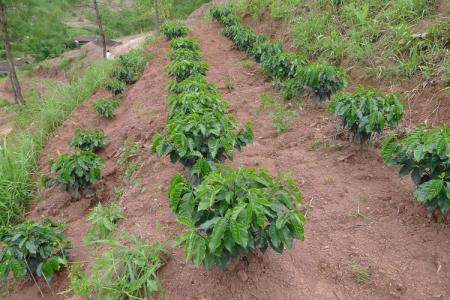Costa Rica Red Kadura Washed Coffee Bean Grind Scale Taste Variety Introduction
Introduction to the varieties of grinding scale of red Kaddura washed coffee beans in Costa Rica
Coffee was introduced into Costa Rica from Cuba in 1729. Today, its coffee industry is one of the well-organized industries in the world, with a yield of 1700 kg per hectare. Costa Rica has only 3.5 million people but 400m coffee trees, and coffee exports account for 25 per cent of the country's total exports. Costa Rica's volcanic soil is very fertile and well drained, especially in the central plateau CentralPlateau, where the soil consists of successive layers of ash and dust. Costa Rica was therefore the first country in Central America to grow coffee and bananas for commercial value. Coffee and bananas are the country's main exports.
Forgive me for talking for so long. I haven't found any good coffee beans for too long, so I have to complain. This red Kaduai from Costa Rica is part of San Idro Manor, which has a history of more than 70 years. It was developed by the father of current farmer Anna Victoria from a small farm. It is now run by Jorge and Anna Victoria, who have bought more and more land and micro-batch processing equipment over the years, shortly after the micro-batch processing equipment was installed. The water crisis in Costa Rica emerged in the early 1990s, when the government greatly restricted the use of water to treat coffee. The introduction of radical water resources and pollution laws by the Costa Rican government had a great impact on the coffee industry. at that time, the coffee industry had to get rid of the traditional washing method. So Jorge and Anna Victoria used the sun treatment method from the Pillon treatment plant to treat the coffee beans on the farm, which only produced sun-treated coffee beans, constantly improving the production technology at the same time. To ensure absolute natural sun treatment, the use of solar energy to ferment raw beans, there is no type of inorganic waste and organic waste left on the farm. [time-limited free delivery] Red Kaduai, Chateau San Idro, Costa Rica
Excellent Costa Rican coffee is called "extra hard beans". This kind of coffee can grow above 1500 meters above sea level. Altitude has always been a problem for coffee growers. The higher the altitude, the better the coffee beans, not only because the higher altitude can increase the acidity of the coffee beans and thus increase the flavor, but also because the night temperature at the higher altitude is lower, which can make the trees grow slowly, thus the flavor of the coffee beans is stronger. In addition, due to the high altitude drop caused by sufficient rainfall, it is very beneficial to the growth of coffee trees. However, its negative effect is to increase additional transportation costs, which is likely to make coffee production unprofitable. The coffee industry in Costa Rica has adopted new technologies to increase efficiency, including using "electric eyes" to select beans and identify coffee beans of irregular size.

Important Notice :
前街咖啡 FrontStreet Coffee has moved to new addredd:
FrontStreet Coffee Address: 315,Donghua East Road,GuangZhou
Tel:020 38364473
- Prev

Flavor description of Brazilian Bourbon Coffee introduction to the Grinding scale of Variety producing areas
Bourbon species, native to the Indian Ocean (now known as Reunion Island), is the second species caused by the mutation of Typica. It belongs to the oldest coffee variety in existence. The green fruit will show bright red when it is ripe, while the yellow bourbon species is derived from the hybridization of bourbon species with other varieties. Because of its
- Next

Introduction to varieties of Ugandan Coffee produced by Flavor description, Grinding scale and Taste treatment
Description of Ugandan Coffee Flavor description, Grinding scale, Taste treatment Variety introduction in Uganda Coffee production area varieties are generally good as long as raw beans are not 100 or yellowed, with low ripe fruit aroma, such as red wine taste, and thick mellow thickness, similar to some Kenyan beans with low flavor, but also with a mild soil flavor, so in terms of flavor characteristics.
Related
- Detailed explanation of Jadeite planting Land in Panamanian Jadeite Manor introduction to the grading system of Jadeite competitive bidding, Red bid, Green bid and Rose Summer
- Story of Coffee planting in Brenka region of Costa Rica Stonehenge Manor anaerobic heavy honey treatment of flavor mouth
- What's on the barrel of Blue Mountain Coffee beans?
- Can American coffee also pull flowers? How to use hot American style to pull out a good-looking pattern?
- Can you make a cold extract with coffee beans? What is the right proportion for cold-extracted coffee formula?
- Indonesian PWN Gold Mandrine Coffee Origin Features Flavor How to Chong? Mandolin coffee is American.
- A brief introduction to the flavor characteristics of Brazilian yellow bourbon coffee beans
- What is the effect of different water quality on the flavor of cold-extracted coffee? What kind of water is best for brewing coffee?
- Why do you think of Rose Summer whenever you mention Panamanian coffee?
- Introduction to the characteristics of authentic blue mountain coffee bean producing areas? What is the CIB Coffee Authority in Jamaica?

